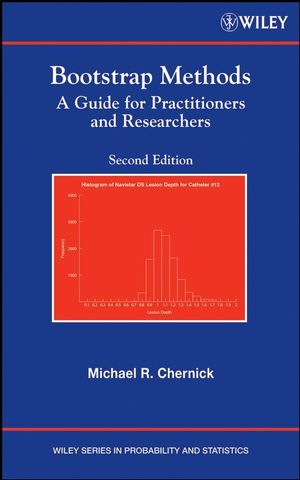Bootstrap Methods: A Guide for Practitioners and Researchers, 2nd EditionISBN: 978-0-471-75621-7
Hardcover
400 pages
November 2007
 This is a Print-on-Demand title. It will be printed specifically to fill your order. Please allow an additional 10-15 days delivery time. The book is not returnable.
|
||||||
Preface to First Edition.
Acknowledgments.
1. What Is Bootstrapping?
1.1. Background.
1.2. Introduction.
1.3. Wide Range of Applications.
1.4. Historical Notes.
1.5. Summary.
2. Estimation.
2.1. Estimating Bias.
2.2. Estimating Location and Dispersion.
2.3. Historical Notes.
3. Confi dence Sets and Hypothesis Testing.
3.1. Confi dence Sets.
3.2. Relationship Between Confi dence Intervals and Tests of
Hypotheses.
3.3. Hypothesis Testing Problems.
3.4. An Application of Bootstrap Confi dence Intervals to Binary Dose–Response Modeling.
3.5. Historical Notes.
4. Regression Analysis.
4.1. Linear Models.
4.2. Nonlinear Models.
4.3. Nonparametric Models.
4.4. Historical Notes.
5. Forecasting and Time Series Analysis.
5.1. Methods of Forecasting.
5.2. Time Series Models.
5.3. When Does Bootstrapping Help with Prediction Intervals?
5.4. Model-Based Versus Block Resampling.
5.5. Explosive Autoregressive Processes.
5.6. Bootstrapping-Stationary Arma Models.
5.7. Frequency-Based Approaches.
5.8. Sieve Bootstrap.
5.9. Historical Notes.
6. Which Resampling Method Should You Use?
6.1. Related Methods.
6.2. Bootstrap Variants.
7. Effi cient and Effective Simulation.
7.1. How Many Replications?
7.2. Variance Reduction Methods.
7.3. When Can Monte Carlo Be Avoided?
7.4. Historical Notes.
8. Special Topics.
8.1. Spatial Data.
8.2. Subset Selection.
8.3. Determining the Number of Distributions in a Mixture Model.
8.4. Censored Data.
8.5. p-Value Adjustment.
8.6. Bioequivalence Applications.
8.7. Process Capability Indices.
8.8. Missing Data.
8.9. Point Processes.
8.10. Lattice Variables.
8.11. Historical Notes.
9. When Bootstrapping Fails Along with Remedies for
Failures.
9.1. Too Small of a Sample Size.
9.2. Distributions with Infi nite Moments.
9.3. Estimating Extreme Values.
9.4. Survey Sampling.
9.5. Data Sequences that Are M-Dependent.
9.6. Unstable Autoregressive Processes.
9.7. Long-Range Dependence.
9.8. Bootstrap Diagnostics.
9.9. Historical Notes.
Bibliography 1 (Prior to 1999).
Bibliography 2 (1999–2007).
Author Index.
Subject Index.



